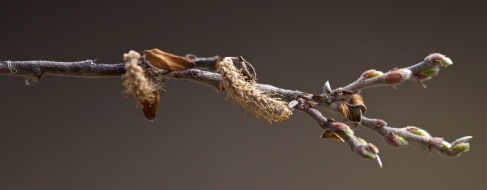Trees and shrubs are ubiquitous around the world. This is one of the most common patterns in nature. Where there is land, there is typically some sort of vegetation.
Given this simple pattern, it is tempting to ask a simple question:
“Where do trees come from?”

The simple answer is, “Well, not from the soil. And not from seeds. Or from water, really. In fact, trees are mostly just air”
Okay, this simple answer is in many small ways untrue, but generally, what you think of when you picture a tree all came from the air, or more specifically from CO2 in the air. The bulk of a tree is just that, carbon from CO2 that has been converted into wood and leaves.
For example, the grayleaf willow (Salix glauca) branch above was, until very recently, part of the atmosphere floating above arctic Greenland. As was the floor currently beneath my feet (minus the arctic bit…or so I hope).
I think this is cool for a couple of reasons. First, it’s not intuitive. Air = Trees is not the most obvious first hypothesis. It took some clever experimenting in the late 1700s to raise the possibility that there was more to plant mass than soil, water and seed (i.e., weigh all of them before and after a plant begins to grow in a controlled environment, except try this in a closed container for one plant and an open container for another. Only thing that differs…airflow!).
The second point of interest are the question that arise from this initial bit of knowledge. Yes, we’re heading towards the carbon cycle… Here’s a brief rundown of how this all fits in. Carbon is a busy molecule. It moves around from the atmosphere, to plants, into animals (microbes and herbivores), other animals (carnivores) – all of whic are also sending it back into the atmosphere via respiration (yes, plants do this too!). It’s found in many forms in the ground (rocks, soils, etc) and gets sucked up and spit out by the oceans. The amount of carbon (in the form of CO2) that is found in the atmosphere at any one time affects how much energy from the sun gets trapped near the earth’s surface before it trickles back into space. This is a big component of what determines global temperatures/climate. Without the carbon cycle, the world would be a much colder place (or perhaps very hot, it depends…)!
Despite the huge effect that atmospheric carbon has on temperatures down at earth’s surface, it makes up only a tiny fraction of all the carbon that exists in the world (global carbon pool). About 80% of the world’s carbon is locked up in the lithosphere, i.e. in rocks, but if we remove that from the picture, the atmosphere still only makes up about 1.5% of the remaining global carbon pool (rather than 0.00001% if we included the rocks). Again excluding the lithosphere, living biomass (including trees and animals/microbes) is about about 1.7% of the remaining global carbon. The bulk of non-lithospheric carbon is dissolved in solution with the oceans. Here’s a pie chart showing the breakdown (again, excluding the lithosphere*):
The proportions represented by those little green and blue slivers in the above graph are vital for life to persist on the planet. Amazing how a little carbon in the right place can have such an impact!
So next time a little kid asks you were trees come from, make sure he/she is sitting down before you start your lengthy explanation. That, or maybe just tell him/her to go away and stop bothering you.
Oh, and in case you were wondering, there are about 75 million gigatons of carbon on earth. A single gigaton is roughly equal in weight to 175 million African elephants.
*Note: I’ve removed the lithosphere from these data because it overwhelms the chart. Carbon doesn’t move in and out of the lithosphere as quickly as the other pools, although that doesn’t mean it is not important. Had I left the lithosphere in, the slivers for atmosphere and living biomass would be almost imperceptible (much like aquatic biosphere is in the current one)! The numbers I used to create this chart were taken from an article published by Falkowski and colleagues in a 2000 issue of Science magazine.




Recent Comments